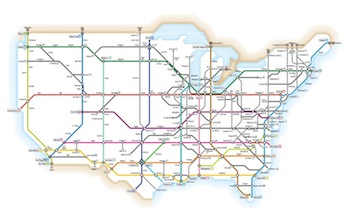After six decades of rising automobile use, the trend for American drivers is finally down.
Over the past eight years, Americans have cut per-person driving miles by 7%, reports US PIRG Education Fund, which means it’s time to stop prioritizing funds for roads instead of public transportation.
The trend isn’t down because of the recession and economic factors. In the 23 states where per-person driving miles are falling faster than the national average, only six states have unemployment rates higher than the national average.
“There’s a national decline in driving that is shared by almost every state,” says Phineas Baxandall, Transportation Program Director for the U.S. PIRG Education Fund. “It’s time for policy makers to wake up and realize the driving boom is over. We need to reconsider expensive highway expansions and focus on alternatives such as public transit and biking — which people increasingly use to get around.
Driving is down by double-digit percentage reductions in many states from a peak around 2004, including Alaska, Colorado, Delaware, Florida, Georgia, Indiana, Mississippi, New Hampshire, New Mexico, New York, Oregon, Pennsylvania, South Carolina, Texas, Utah, Vermont, West Virginia, Wyoming, and the District of Columbia.
But there are four states bucking the decline: Alabama, Louisiana, Nevada and North Dakota.
The report, “Moving Off the Road: A State-by-State Analysis of the National Decline in Driving,” is based on information gathered every year by the Federal Highway Administration. Data gathered for the first half of 2013 suggests that the decline is continuing this year.
“Given these trends, we need to press the reset button on our transportation policy,” says Baxandall. “Just because past transportation investments overwhelmingly went to highway construction, doesn’t mean that continues to be the right choice for America’s future.”
Dramatic State-to-State Differences
America’s "driving boom" began after World War II and per-driver miles increased steadily over the subsequent 60 years, driven by the growth of suburbs, low gas prices and rising automobile ownership.
The average American drove 9,455 miles in 2011, but there are vast differences in the number of miles driven state to state, reports US PIRG.

In Wyoming, for example, the average resident logs more than 16,000 miles annually, which is the equivalent of every person in the state (adult or child!) getting behind the wheel and driving across the state and back every month.
The fewest number of miles are logged by residents in the District of Columbia (5,774 miles annually), followed by Alaska, Hawaii, New York, Rhode Island and Pennsylvania (all with less than 8,000 miles per year, per driver).
As you might expect, people tend to drive more or less depending on how urban or rural the state. In urban areas, there’s less need to drive long distances to get to work, do errands and recreate. Many cities are seeking to leverage this advantage with investments in more sustainable modes of transportation.
In notoriously car-friendly and traffic-congested Los Angeles, for example, the municipal government has been able to decrease car ownership by greatly expanding bike lanes (doubled to 292 miles) and light rail (26% increase in the past eight years). In 2012, cities across southern California have passed a visionary regional growth plan that will guide transportation investments there through 2035.
The Case for Smart Growth
Research by the International Energy Agency suggests that serious investments in improving urban transportation systems would have a huge payback economically and environmentally, to the tune of $70 trillion in savings on fuel, vehicles and infrastructure.
In rural and suburban areas, smart growth strategies already are leading the housing recovery. Rentals are leading the way in walkable communities and the slowest areas to recover will be outer suburbs sparsely populated areas with low walkability, according to a May 2012 report by the Demand Institute.
One example is an approach advocated by designer Rick Harrison, called Prefurbia: a mashup of the words "suburbia" and "preferred."
Central to his planning is a concept called "coving," which adapts community development to the unique contours of the land. There are no straight streets, which helps cut back on the amount of impervious surfaces, and setbacks differ for each piece of property in order to help with rainwater absorption.
Harrison told Midwest Energy News:
"New urbanism produces an enormous amount of infrastructure, so when you have all the short dimensions and homes in compressed states it means you’re filling up streets and alleys with pavement, versus green space. We do the opposite. We concentrate on the least amount of pavement and we can achieve similar densities with a whole lot less cost and environmental impact. The perception is new urbanism is an environmental solution but the reality is, it’s the most paved, most roof-topped per acre approach to density, which means it has the most runoff and is the most expensive."
In contrast, the Prefurbia approach makes affordability part of the equation, attracting mostly middle mass-market buyers.
Read more about America’s driving habits:
